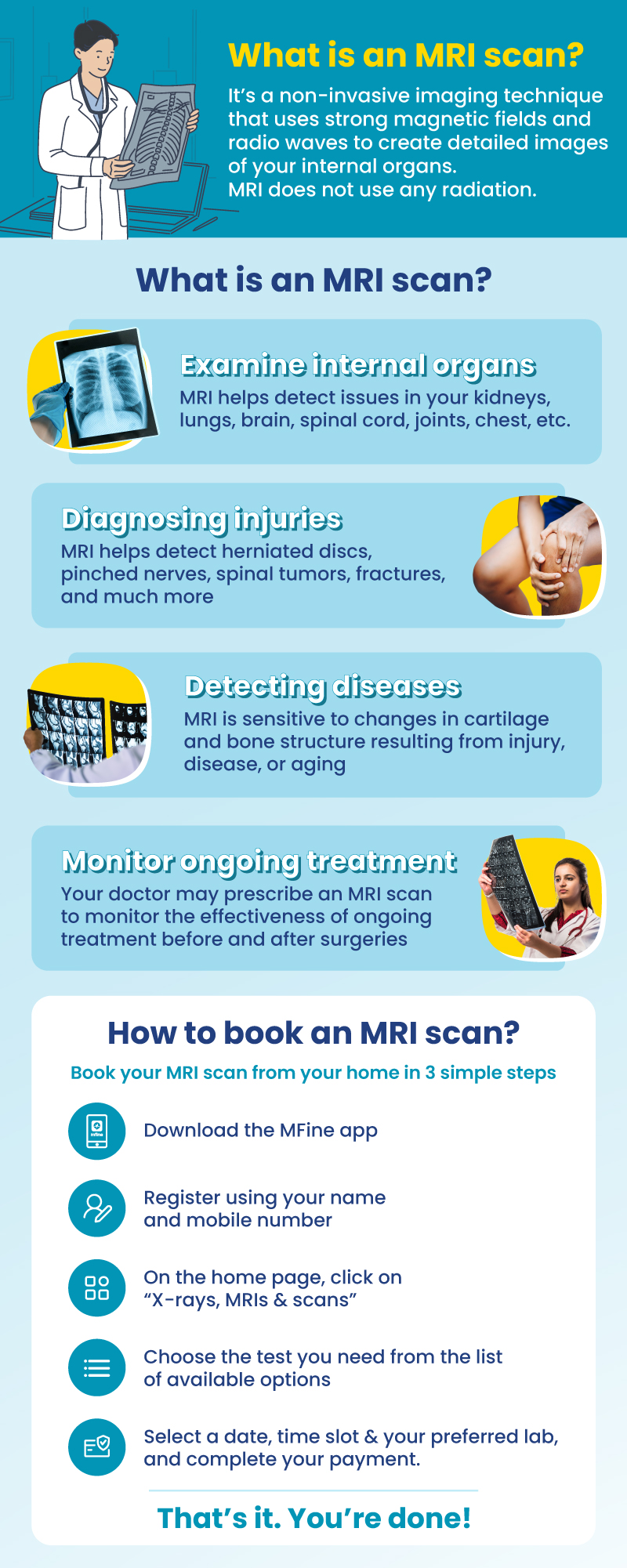
MRI Spine Scan or Magnetic Resonance Imaging Spine is a special type of scan that uses magnetic rays to create a detailed image of the spine.
MFine offers you high-quality lab options and an excellent discount of upto 50%, for your MRI Spine in Mumbai.
|
MRI Scan Spine in Mumbai by MFine
|
Generally, the market price of an MRI spine scan is above ₹7000 but with us, you can get it for ₹3,150 only.
Avail of this exclusive offer by calling us on
Or you can click on the button below for us to call you back.
You can book an online doctor consultation after booking the test.
Spine MRI scan costs in Mumbai
MRI Scan Spine Cost in Mumbai |
Offer Price |
| Whole MRI Scan Spine Mumbai Price | ₹6300 |
| MRI Cervical Spine Price in Mumbai | ₹3150 |
| MRI Dorsal Spine Price in Mumbai | ₹3150 |
| MRI Lumbar Spine Price in Mumbai | ₹3150 |
To explore further, reach out to us at ☏08061970525.
Why should I book an MRI through MFine?
|
Exclusive Benefits with MFine
(1) Certified labs
Get access to over 600+ labs certified by NABL and NABH
(2) Same-day slot available
Get scans done on the same day
(3) Quick and convenient
Get reports in 12 hours and digital films in 15 – 20 minutes
(4) FREE Consultation
Post scans, consult a doctor for free to review your report
MRI of the Spine
Let’s take a closer look at the diverse parts and segments of the spine.
- Vertebrae: The spine consists of 33 vertebrae arranged in a specific pattern. These bones are categorized into five regions: cervical (neck), thoracic (upper back), lumbar (lower back), sacral (pelvic), and coccygeal (tailbone). Each vertebra has a unique structure and function, and they are stacked on top of each other, forming the vertebral column.
- Facet Joints: Situated between adjacent vertebrae, the facet joints are synovial joints that play a significant role in promoting spinal flexibility. They enable smooth movements and articulation between vertebrae, allowing for various activities such as bending, twisting, and turning. The surfaces of these joints are coated with cartilage, which helps reduce friction during movement.
- Intervertebral Disks: Intervertebral disks are flat, round cushions found between adjacent vertebrae. Composed of a tough outer layer called the annulus fibrosus and a gel-like center called the nucleus pulposus, these disks act as shock absorbers for the spine. They help cushion the impact of daily activities such as walking, jumping, and running, protecting the vertebrae from rubbing against each other and minimizing wear and tear.
- Spinal Cord and Nerves: The spinal cord is a bundle of nerves that runs through the vertebral column’s central canal. It serves as a vital communication pathway between the brain and the rest of the body. The spinal cord is responsible for transmitting sensory information from various body parts to the brain and delivering motor signals from the brain to muscles, enabling voluntary movements.
- Soft Tissues: Alongside bones and nerves, the spine is supported by several soft tissues that provide stability, maintain alignment, and enable bodily movements:
- Ligaments: These connective tissues attach bone to bone, providing stability to the spine and limiting excessive movement between vertebrae.
- Muscles: The muscles surrounding the spine are essential for maintaining proper posture, supporting the body’s weight, and facilitating movements. Strong and flexible back muscles play a vital role in reducing the risk of spinal injuries.
- Tendons: Tendons connect muscles to bones, enabling coordinated and controlled movements. They transmit the force generated by muscles to the bones, allowing for smooth and precise actions.

What are the different spine segments?
The human spine is a crucial part of our body that helps us stand upright, supports our weight, and protects our delicate nervous system. It is divided into five main sections, each serving a specific purpose:
(1) Cervical (neck) spine:
- Made up of 7 vertebrae (bones) called C1 to C7.
- Situated in the neck region, it allows us to move our head in different directions.
- Also, protects the important neural pathways that connect our brain to the rest of the body.
(2) Thoracic (middle back) spine:
- Comprising 12 vertebrae labeled T1 to T12.
- Found in the middle back area and attached to the ribcage, providing support for the chest region.
- Its main function is to protect the vital organs in the chest and upper abdomen.
(3) Lumbar (lower back) spine:
- Consists of 5 vertebrae known as L1 to L5.
- Located in the lower back, it plays a significant role in supporting the body’s weight.
- The lumbar spine is responsible for our ability to bend, lift, and move freely.
(4) Sacrum:
- This is a triangular bone formed by the fusion of 5 sacral vertebrae.
- It connects the spine to the hip bones and forms part of the pelvis, providing stability to the lower back and hips.
(5) Coccyx (tailbone):
- Composed of coccygeal vertebrae, typically around 3 to 5 in number.
- Situated at the end of the spine.
- While it doesn’t have a significant functional role, it serves as an attachment point for certain muscles and ligaments.
Which disorders can be diagnosed using a spine MRI?
A spine MRI serves as a comprehensive diagnostic tool to diagnose a multitude of disorders, including
- Arthritis, particularly ankylosing spondylitis affecting spinal joints
- Back strains and sprains caused by injuries or excessive strain
- Birth defects like spina bifida impacting spinal development
- Bone spurs, abnormal bony growths affecting spinal structures
- Curvatures of the spine, encompassing scoliosis and kyphosis
- Neuromuscular diseases, including ALS (amyotrophic lateral sclerosis)
- Nerve injuries such as spinal stenosis, sciatica, and pinched nerves
- Osteoporosis leading to weakened and brittle bones
- Spinal cord injuries involving fractures, herniated disks, and paralysis
- Spine tumors and cancerous growths in the spinal region
- Spine infections like meningitis and osteomyelitis
Why would a doctor prescribe a spine MRI?
A doctor may suggest a spine MRI to address the following indications:
- Diagnosing and evaluating spinal conditions like arthritis, bone spurs, and curvatures (scoliosis, kyphosis).
- Assessing and monitoring back injuries, including strains, sprains, and fractures.
- Investigating nerve-related issues such as spinal stenosis, sciatica, and pinched nerves.
- Detecting and evaluating spinal cord injuries, herniated disks, and spinal tumors.
- Diagnosing infections like meningitis and osteomyelitis affects the spine.
Prerequisites for a Spine MRI
Prior to a spine MRI, certain prerequisites are essential, including:
- Medical referral: A doctor’s prescription or referral is typically necessary to book a spine MRI.
- Pre-scan questionnaire: Patients may be required to complete a questionnaire to assess MRI suitability and any contraindications.
- Medical history disclosure: Patients should inform the healthcare provider about any pre-existing medical conditions, allergies, or prior surgeries.
- Metal object removal: To prevent MRI interference, patients need to remove metal items like jewelry, watches, piercings, and hearing aids.
- Pregnancy status: Female patients should inform the healthcare provider if they are pregnant or suspect pregnancy, as MRI scans are generally avoided during pregnancy, especially in the first trimester.
FAQs
What are the symptoms of facet joint damage?
Symptoms of facet joint damage may include localized pain in the affected area of the spine, stiffness, limited range of motion, and pain that worsens with certain movements or positions. The pain may radiate to the buttocks or thighs, but it typically does not extend down the leg like sciatica.
Can you see facet joint inflammation on MRI?
Yes, MRI can detect facet joint inflammation. It can show signs of joint effusion (accumulation of fluid in the joint space) and edema (swelling) in the facet joints, indicating inflammation and potential facet joint-related issues.
Is facet joint pain permanent?
Facet joint pain can vary in severity and duration. In some cases, it may resolve with conservative treatments such as physical therapy, anti-inflammatory medications, or injections. However, for some individuals, facet joint pain may become chronic and require ongoing management.
Can facet pain be cured?
The treatment for facet joint pain depends on the underlying cause and severity of the condition. While some cases may improve with conservative treatments, such as physical therapy or medications, others may require more targeted interventions, including facet joint injections or nerve ablation procedures. A healthcare professional can assess the individual case and recommend appropriate treatment options.
What is the difference between facet and disc back pain?
Facet joint pain originates from the small joints that connect vertebrae together, called facet joints. Disc-related back pain, on the other hand, is associated with issues in the intervertebral discs that act as cushions between the vertebrae. Both facet and disc pain can cause localized back pain, but facet joint pain typically does not cause leg pain, while disc-related pain can often lead to radiating leg pain, known as sciatica.
What is L4 and L5 facet?
L4 (fourth lumbar vertebra) and L5 (fifth lumbar vertebra) are specific levels in the lumbar spine. The L4-L5 facet joint is the joint connecting the fourth and fifth lumbar vertebrae. Issues in this facet joint can contribute to lower back pain and other symptoms.
Can an MRI detect a slipped disc?
Yes, an MRI can detect a slipped disc, also known as a herniated disc. The MRI can provide detailed images of the spinal discs, and it will show if the inner soft material (nucleus pulposus) has protruded or herniated through the tough outer layer (annulus fibrosus) of the disc.
What does a spine MRI with contrast show?
A spine MRI with contrast material shows detailed images of the spinal structures, including discs, nerves, blood vessels, and surrounding tissues, enhanced by a contrast agent to highlight abnormalities, inflammation, tumors, or other issues.
How do doctors check for a slipped disc?
Doctors can check for a slipped disc through a combination of medical history, physical examination, and imaging tests. The physical examination may include checking for symptoms like pain, weakness, or changes in reflexes. Imaging tests like MRI or CT scans are usually used to confirm the presence and location of a slipped disc.
How is a slipped disc detected?
A slipped disc is typically detected through imaging tests, such as MRI or CT scans. These tests provide detailed images of the spinal discs and surrounding structures, allowing healthcare providers to visualize any herniation or displacement of disc material.
Is MRI or CT better for a herniated disc?
MRI is generally considered better for evaluating a herniated disc. MRI provides superior soft tissue contrast, which allows for better visualization of the intervertebral discs, nerve roots, and surrounding structures. CT scans are useful for assessing bony structures but may not provide as much detail for soft tissue evaluation compared to MRI.
Read a complete blog on CT scan vs MRI: Which is better?
Other topics you may be interested in
| For further assistance call us on ☏08061970525 |

 Call us:
Call us:


 Call
Now
Call
Now